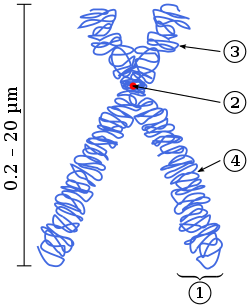A chromosome is an organized structure of DNA and protein that is found in cells. A chromosome is a single piece of DNA that contains many genes, regulatory elements and other nucleotide sequences. Chromosomes also contain DNA-bound proteins, which serve to package the DNA and control its functions. The word chromosome comes from the Greekχρῶμα (chroma, color) and σῶμα (soma, body) due to their property of being stained very strongly by some dyes. Chromosomes vary extensively between different organisms. The DNA molecule may be circular or linear, and can contain anything from 10,000 to 1,000,000,000[1]nucleotides in length. Typically eukaryotic cells (cells with nuclei) have large linear chromosomes and prokaryotic cells (cells without defined nuclei) have smaller circular chromosomes, although there are many exceptions to this rule. Furthermore, cells may contain more than one type of chromosome; for example, mitochondria in most eukaryotes andchloroplasts in plants have their own small chromosomes. In eukaryotes, nuclear chromosomes are packaged by proteins into a condensed structure called chromatin. This allows the very long DNA molecules to fit into the cell nucleus. The structure of chromosomes and chromatin varies through the cell cycle. Chromosomes may exist as either duplicated or unduplicated—unduplicated chromosomes are single linear strands, whereas duplicated chromosomes (copied during synthesis phase) contain two copies joined by a centromere. Compaction of the duplicated chromosomes during mitosis and meiosis results in the classic four-arm structure (pictured to the right).
"Chromosome" is a rather loosely defined term. In prokaryotes, a small circular DNA molecule may be called either a plasmid or a small chromosome. These small circular genomes are also found in mitochondria and chloroplasts, reflecting their bacterial origins. The simplest chromosomes are found in viruses: these DNA or RNA molecules are short linear or circular chromosomes that often lack any structural proteins.

No comments:
Post a Comment